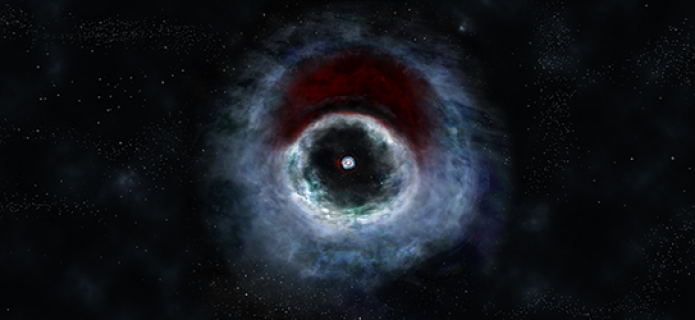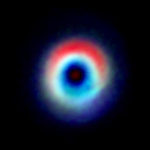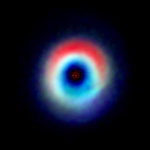ALMA Unveils Details of Planet Formation around Binary Star
Using ALMA, astronomers have taken a new, detailed look at the very early stages of planet formation around a binary star. Embedded in the outer reaches of a double star's protoplanetary disk, the researchers discovered a striking crescent-shape region of dust that is conspicuously devoid of gas. This result, presented at the AAAS meeting in Washington, D.C., provides fresh insights into the planet-forming potential of a binary system.
Astronomers struggle to understand how planets form in binary star systems. Early models suggested that the gravitational tug-of-war between two stellar bodies would send young planets into eccentric orbits, possibly ejecting them completely from their home system or sending them crashing into their stars. Observational evidence, however, reveals that planets do indeed form and maintain surprisingly stable orbits around double stars.
To better understand how such systems form and evolve, astronomers using the Atacama Large Millimeter/submillimeter Array (ALMA) took a new, detailed look at the planet-forming disk around HD 142527, a binary star about 450 light-years from Earth in a cluster of young stars known as the Scorpius-Centaurus Association.
The HD 142527 system consists of a main star a little more than twice the mass of our Sun and a smaller companion star only about a third the mass of our Sun. They are separated by approximately one billion miles: a little more than the distance from the Sun to Saturn. Previous ALMA studies of this system revealed surprising details about the structure of the system's inner and outer disks.
"This binary system has long been known to harbor a planet-forming corona of dust and gas," said Andrea Isella, an astronomer at Rice University in Houston, Texas. "The new ALMA images reveal previously unseen details about the physical processes that regulate the formation of planets around this and perhaps many other binary systems."
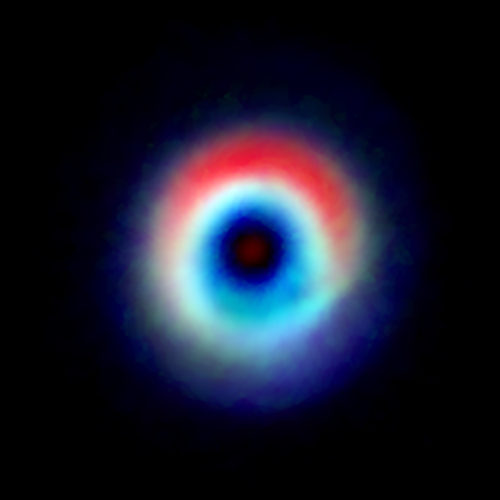
A composite image of the HD 142527 binary star system from data captured by the Atacama Large Millimeter/submillimeter Array shows a distinctive arc of dust (red) and a ring of carbon monoxide (blue and green). The red arc is free of gas, suggesting the carbon monoxide has "frozen out," forming a layer of frost on the dust grains in that region. Astronomers speculate this frost provides a boost to planet formation. Credit: Andrea Isella/Rice University; B. Saxton (NRAO/AUI/NSF); ALMA (NRAO/ESO/NAOJ)
Planets form out of the expansive disks of dust and gas that surround young stars. Small dust grains and pockets of gas eventually come together under gravity, forming larger and larger agglomerations and eventually asteroids and planets. The fine points of this process are not well understood, however. By studying a wide range of protoplanetary disks with ALMA, astronomers hope to better understand the conditions that set the stage for planet formation across the Universe.
ALMA's new, high-resolution images of HD 142527 show a broad elliptical ring around the double star. The disk begins incredibly far from the central star — about 50 times the Sun-Earth distance. Most of it consists of gases, including two forms of carbon monoxide (13CO and C180), but there is a noticeable dearth of gases within a huge arc of dust that extends nearly a third of the way around the star system.
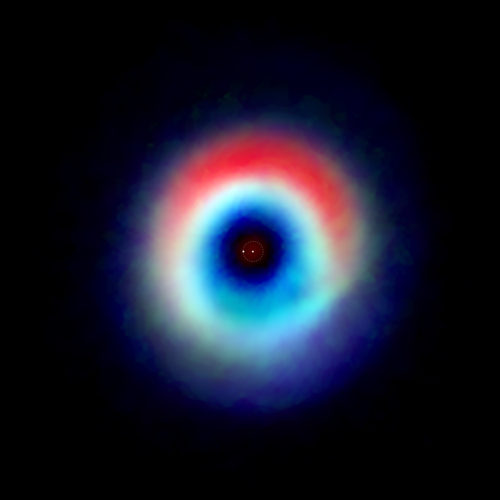 A composite image of the HD 142527 binary star system from data captured by the Atacama Large Millimeter/submillimeter Array shows a distinctive arc of dust (red) and a ring of carbon monoxide (blue and green). The red arc is free of gas, suggesting the carbon monoxide has "frozen out," forming a layer of frost on the dust grains in that region. Astronomers speculate this frost provides a boost to planet formation. The two dots in the center represent the two stars in the system. Credit: Andrea Isella/Rice University; B. Saxton (NRAO/AUI/NSF); ALMA (NRAO/ESO/NAOJ)
A composite image of the HD 142527 binary star system from data captured by the Atacama Large Millimeter/submillimeter Array shows a distinctive arc of dust (red) and a ring of carbon monoxide (blue and green). The red arc is free of gas, suggesting the carbon monoxide has "frozen out," forming a layer of frost on the dust grains in that region. Astronomers speculate this frost provides a boost to planet formation. The two dots in the center represent the two stars in the system. Credit: Andrea Isella/Rice University; B. Saxton (NRAO/AUI/NSF); ALMA (NRAO/ESO/NAOJ)
This crescent-shaped dust cloud may be the result of gravitational forces unique to binary stars and may also be the key to the formation of planets, Isella speculates. Its lack of free-floating gases is likely the result of them freezing out and forming a thin layer of ice on the dust grains.
"The temperature is so low that the gas turns into ice and sticks to the grains," Isella said. "This process is thought to increase the capacity for dust grains to stick together, making it a strong catalyst for the formation of planetesimals, and, down the line, of planets."
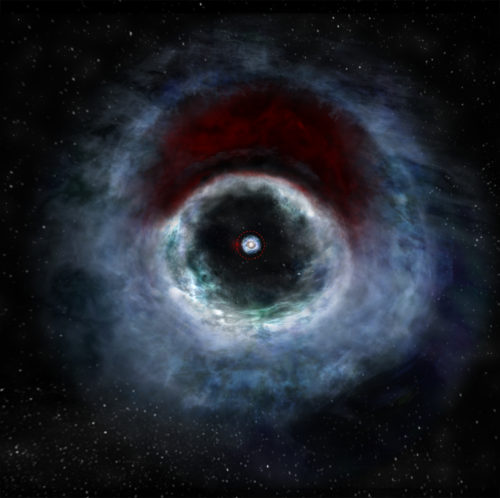
Artist impression of the HD 142527 binary star system based on data from the Atacama Large Millimeter/submillimeter Array (ALMA). The rendition shows a distinctive arc of dust (red) embedded in the protoplanetary disk. The red arc is free of gas, suggesting the carbon monoxide has "frozen out," forming a layer of frost on the dust grains in that region. Astronomers speculate this frost provides a boost to planet formation. The two dots in the center represent the two stars in the system. Credit: B. Saxton (NRAO/AUI/NSF)
"We've been studying protoplanetary disks for at least 20 years,"Isella said. "There are between a few hundred and a few thousands we can look at again with ALMA to find new and surprising details. That's the beauty of ALMA. Every time you get new data, it's like opening a present. You don't know what's inside."
HD 142527 will be the subject of an upcoming paper led by Rice postdoctoral fellow Yann Boehler, who is working in Isella’s group.
Additional information
The Atacama Large Millimeter/submillimeter Array (ALMA), an international astronomy facility, is a partnership of the European Organisation for Astronomical Research in the Southern Hemisphere (ESO), the U.S. National Science Foundation (NSF) and the National Institutes of Natural Sciences (NINS) of Japan in cooperation with the Republic of Chile. ALMA is funded by ESO on behalf of its Member States, by NSF in cooperation with the National Research Council of Canada (NRC) and the Ministry of Science and Technology (MOST) in Taiwan and by NINS in cooperation with the Academia Sinica (AS) in Taiwan and the Korea Astronomy and Space Science Institute (KASI).
ALMA construction and operations are led by ESO on behalf of its Member States; by the National Radio Astronomy Observatory (NRAO), managed by Associated Universities, Inc. (AUI), on behalf of North America; and by the National Astronomical Observatory of Japan (NAOJ) on behalf of East Asia. The Joint ALMA Observatory (JAO) provides the unified leadership and management of the construction, commissioning and operation of ALMA.
Contacts
Nicolás Lira T.
Education and Public Outreach Coordinator
Joint ALMA Observatory
Santiago, Chile
Tel: +56 2 24 67 65 19
Cell: +56 9 94 45 77 26
Email: [email protected]
Charles E. Blue
Public Information Officer
National Radio Astronomy Observatory
Charlottesville, Virginia, USA
Tel: +1 434 296 0314
Cell: +1 202 236 6324
E-mail: [email protected]
Richard Hook
Public Information Officer, ESO
Garching bei München, Germany
Tel: +49 89 3200 6655
Cell: +49 151 1537 3591
Email: [email protected]
Masaaki Hiramatsu
Education and Public Outreach Officer, NAOJ Chile
Observatory
Tokyo, Japan
Tel: +81 422 34 3630
E-mail: [email protected]
